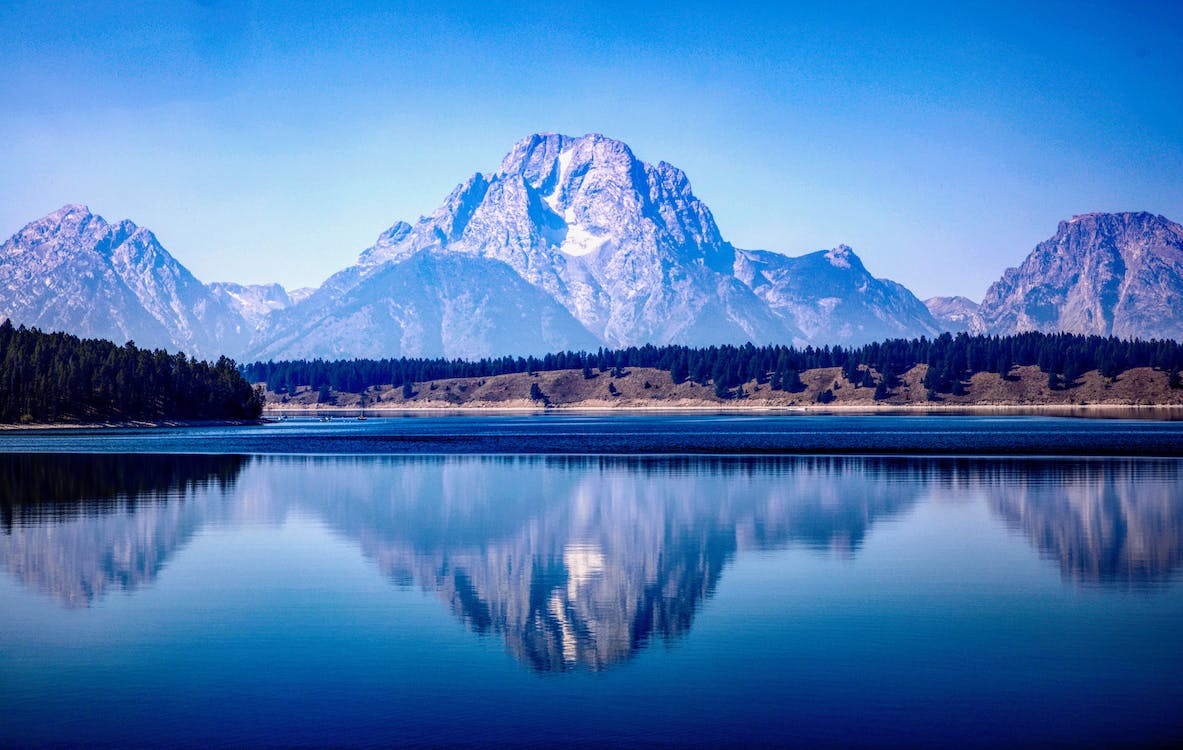Grand Teton National Park is a spectacular national park in Wyoming and just 10 miles from Yellowstone National Park. It is connected by the National Park Service-managed John D. Rockefeller, Jr. Memorial Parkway. It covers approximately 310,000 acres. Also, the 40-mile-long Teton Range major peaks are included in the park, and most of the valley’s northern sections known as Jackson Hole.
Along with surrounding national forests, these three protected areas constitute the almost 18,000,000-acre (7,300,000 ha) Greater Yellowstone Ecosystem, one of the world’s largest intact mid-latitude temperate ecosystems.
You can find many lakes with deep blue pools, echoing the stillness and color of the glaciers that shaped them. The Snake River descends through the park in a rush of water, and the dense forests blanketing the mountainsides provide habitat for a vast array of fauna and flora.
WILDLIFE IN THE PARK
Some prehistoric species can be found in this park, due to their strict preservation and conservation of the area. About 1000 plant species, dozens of mammal species, nearly 300 bird species, a variety of fish species, reptiles, and amphibians inhabit the park.
Visitors experience the reality of wildlife in the park. Black bears, coyotes, bison, bald eagles, and grizzlies are among the most common mammals, including the small ones like Uinta ground squirrel. These are just free crossing the roadways, especially early in the morning and late evening. That is why slow driving is advised for the safety of both the animals and visitors.
A few wildlife viewing areas in the park include Timbered Island, Oxbow Bend, Mormon Row, Cascade Canyon, Snake River, and Black Tail Pond.
HISTORY
The Park is named after the tallest mountain Grand Teton which is found in the area. Aside from being a home to stunning alpine scenery in the US, the area also has a colorful history.
It is believed the John Colter, the first Anglo-American to see the saw-edged Teton peaks. After he traveled with Lewis and Clark to the Pacific, he left the expedition during its return trip down Missouri in 1807 to join two fur trappers headed back into the wilderness.
It was three years of wandering through the northern Rocky Mountains until he eventually found his way into the valley at the Tetons’ base, which would later be called Jackson Hole. Other travelers followed Colter’s footsteps. And the French-Canadian trappers gave the mountain range the bawdy name of “Grand Tetons,” meaning “big breasts” in French. Almost all sorts of Park’s visitors passed through the Jackson Hole, until 1887, settlers established the first permanent habitation.
The efforts to preserve the area as a national park began in the late 19th century. In 2019, the Park celebrated its 90 years of being a national park since it was established in1929 to protect the Range’s significant peaks. The Jackson Hole’s valley was a private property until 1930; it was acquired by the conservationists led by John D. Rockefeller, Jr., who began purchasing land to be added to the existing national park.
The public did not agree and support this action, and there were repeated Congressional efforts to abolish the measures.
And finally, in 1929, Grand Teton National Park after more than a decade of political maneuvering. However, the park only encompasses the mountains and a narrow strip at the base due to a concession to the ranchers and tourist operators. Jackson Hole was excluded from the park and selected merely as a scenic preserve.
INCREDIBLE ADVENTURES
Rafting at the Snake River
On hot summer days, you can best cool down at a wild, scenic raft trip on the Snake River. It winds beneath the shadow of the Tetons, and it has more than 300,000 visitors a year. Visitors often will see wildlife such as moose, beavers, eagles, osprey, and more.
There are guides along the trip that share their knowledge of the wildlife, history, and geology. You can book a raft trip with a freshly prepared lunch or dinner along the Snake River bank. Make sure to bring your camera with you to capture some memories here.
Wildlife Viewing
If you love to see yourself the living and free wildlife such as moose, bears, bison, elk, eagles, pronghorn, etc., the park offers this wildlife viewing regularly. It’s best to ask at the Visitor Center or Activity Desk about this activity. Jackson Lake Lodge’s activity desk records recent animal sightings. You can find some of the best spots for wildlife viewing at the Willow Flats in front of Jackson Lake Lodge, Oxbow Bend, Elk Ranch Flats, and Moose.
Horseback riding
A trip to the Old West is not complete without a horseback ride through Grand Teton National Park! You can spend a morning or afternoon in Grand Teton horseback riding and experience the park’s priceless scenic views. There is one to two hours of horseback riding offered at the Jackson Lake Lodge, where you’ll enjoy sweeping views of the Tetons, Oxbow Bend, and the Snake River.
Hiking
If you got thrills with hiking, there are a lot of trails that the park offers. You can choose from the most popular short hikes such as Hidden Falls and Inspiration Point, String Lake, Leigh Lake, and Swan and Heron Pond. Or if you want a full-day hike that is more challenging, you can go to Cascade Canyon, Death Canyon, or Paintbrush Canyon and experience towering granite peaks and beautiful remote lakes.

